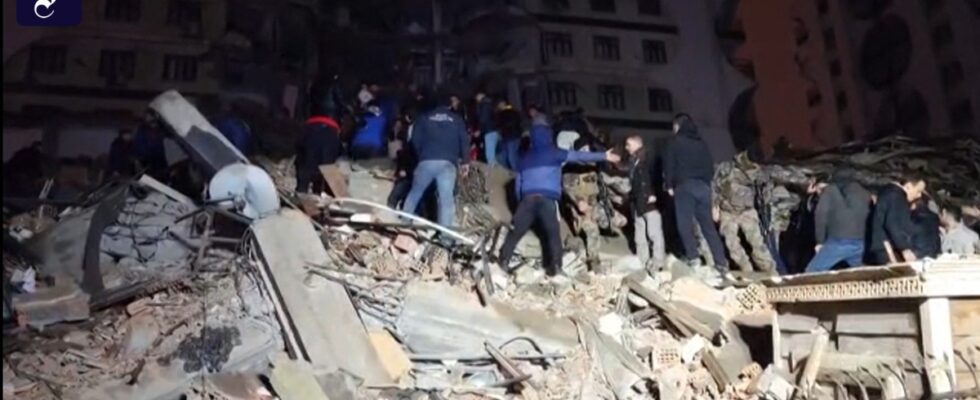BAccording to official figures, more than 230 people died in the severe earthquake in the Turkish-Syrian border region in Syria alone. More than 600 people were injured, Deputy Health Minister Ahmed Dhamirijeh told Syrian state television on Monday. The aid organization SAMS, which works in rebel-controlled areas in Syria, reported more than 100 more fatalities. In Turkey, more than 280 people died and more than 2,300 others were injured, Vice President Fuat Oktay said on Monday.
A 7.4 magnitude earthquake struck southeastern Turkey early Monday morning. According to the civil protection agency Afad, the epicenter was in the province of Kahramanmaras near the Syrian border. Another earthquake measuring 6.6 was measured shortly afterwards in the province of Gaziantep. In an updated assessment, the Geoforschungszentrum Potsdam gave the strength as 7.8 and 6.7.
Syria hit hard
An entire block of houses collapsed in the Syrian province of Idlib. Photos showed rescue teams taking people away on stretchers. The head of the National Earthquake Center, Raed Ahmed, said this was the strongest earthquake to hit Syria since 1995, according to the Syrian state news agency Sana.
The rescue organization White Helmets, for its part, spoke of dozens of deaths. “We are responding with everything we can to rescue those who are under the rubble,” said group leader Raed Al Saleh. “The situation is very tragic,” said one member of the group.
In Syria, heavy rain and sleet made rescue work difficult. Health authorities urged the population to take casualties to emergency facilities. The injured are arriving in large numbers, a representative of the health authorities in Aleppo told the Reuters news agency by phone. A White Helmet representative said scores of people would have to stay outdoors in the winter cold. There were reports from Turkey of injured people who were hoping for the rescue of relatives in front of the rubble of their houses.
According to the interior minister, several provinces in Turkey are affected. More than 1,700 buildings were destroyed, including a hospital in the city of Iskenderun. According to the newspaper “Hürriyet”, a historic castle collapsed in Gaziantep. Rescue teams from all over the country would be brought together, said the Turkish interior minister. In addition, alarm level four was declared and international help was requested. There were a total of 22 aftershocks, some strong. Greece, Italy, Germany, the US and Israel have already pledged help.
Turkish President Recep Tayyip Erdogan wrote on Twitter, “We hope that we can get through this disaster together in the shortest possible time and with as little damage as possible.”
Turkey is an earthquake risk area
Turkey is repeatedly affected by severe earthquakes and has the highest earthquake risk of any country in Europe and the Middle East. The earthquake that shook large parts of the Middle East early Monday morning was the strongest tremor on Earth in 18 months.
The focus of the tremor with a magnitude of 7.8 was almost 40 kilometers northwest of the Turkish industrial city of Gaziantep in the border area with Syria. The quake was felt throughout south-eastern Turkey, almost everywhere in Syria, as well as in Cyprus, Lebanon, Israel and the West Bank. The last time the earth trembled with such magnitude was in July 2021, when an 8.2 magnitude earthquake struck the Alaska Peninsula.
The latest tremor occurred at a depth of between 10 and 15 kilometers in one of the world’s most vulnerable seismic areas, the Levant. Along the east coast of the Mediterranean Sea and its hinterland, the Arabian crustal plate meets two other fragments of the earth’s surface. Arabia slides north along the huge African plate at a rate of around 2.5 centimeters per year and then hits the much smaller Anatolian plate, which covers almost the entire national territory of Turkey.
The Jordan Valley stretches along the border between the African and Arabian plates from the Red Sea to roughly the border area between Turkey and Syria. From there, the so-called East Anatolian Fault points northeast. Monday’s earthquake was in the transition zone between these two tectonic demarcation lines and was the strongest earthquake in this region in decades.
